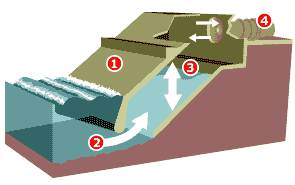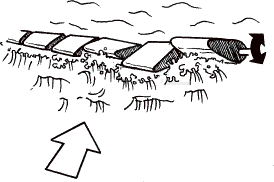Wave Energy
Oscillating Water Column (OWC)Oneof the ways to capture some of this energy is the oscillating water column. When waves hit an OWC, the air inside is compressed and forced through air turbines - these turn the generator and make electricity by electromagnetic induction.
Salter Ducks
The untimely death
of the Salter's Duck The Duck was developed in the late '70s by a team headed by Professor Stephen Salter at Edinburgh University. This was one of several research groups set up after a 1976 judgment by the Department of Energy that wave power was the most promising renewable energy source. By 1982, a consultant was able to report that the duck could be expected, with further development, to produce electricity at a cost of around 5.5 pence (about 12 cents) per kilowatt-hour, a price competitive with nuclear power (the most expensive commercial generation process in use in Britain). Clive Grove-Palmer, a respected department engineer seconded to work on the duck project, estimated that the cost could be got down around 3 pence per kilowatt-hour (about 7 cents). But there was opposition from established energies (especially the atomic energy branch) in the UK and in 1983 data relating to the project was incorrectly put forward making those responsible for the funding to withdraw their support. Some people suspected it had been done deliberately - the researchers did not see the final paper until 8 months after it had sunk the Duck! After a long campaign to save the project, Professor Salter's team was forced to disperse in early 1987. Since the cost inflation (it said that it would cost 10X as much!) of the report has come to light there has been some talk of resurrecting the Duck - but the original researchers have now moved on to other work or retired. However, it does look as if the Duck may rise again! HistoryGetting energy from the waves has been studied since the time of the French Revolution when the first patent was filed in Paris by a father and son named Girard. They noted that ‘the enormous mass of a ship of the line, which no other known force is capable of lifting, responds to the slightest wave motions’. There was little progress in turning wave motions into useful energy until the last quarter of the 20th century, mainly through lack of scientific knowledge of what a wave was, how it travelled and how it could be converted into useful energy. What is a wave?Leonardo da Vinci noted that when the wind blew across a field of corn, it looked as though waves of corn ran across the field – whereas, in fact, the individual heads were only moving slightly. So it is with waves in the sea! The particles themselves do not progress along to the shore - the wave energy does! See Waves. So, unlike hydro-electric power it cannot use a flow of water running in one direction. You cannot put a water wheel in the sea and leave it to revolve and generate electricity, even though, to the watcher on the shore, it appears that the waves are advancing towards the beach in a straight line! A water particle in a wave travels up and down. Its height is the key indication of its power as this is linked to its potential gravitational energy. So the rougher the sea, the more potentially fruitful it is – but also the harder it is to harvest! Wave energy engineers have to design a power station that can absorb the power of the most ferocious waves without being wrecked. Advantages of wave power Wave energy has been hailed as the most promising renewable source for maritime countries. It does no environmental damage and is inexhaustible – the waves go on for ever. Design Issues and Problems Wave power devices have to be carefully planned out. Many are designed to float in the ocean, and can be damaged by powerful waves and storms. Other designs, like the OWC, are attached to a rigid face and are more able to withstand nature's everyday force. Also, to get the most energy from the waves, OWC's are best designed with two-way turbines, so that air can be pushed out or sucked in, always creating energy.
Link:
|
Follow me...
|








